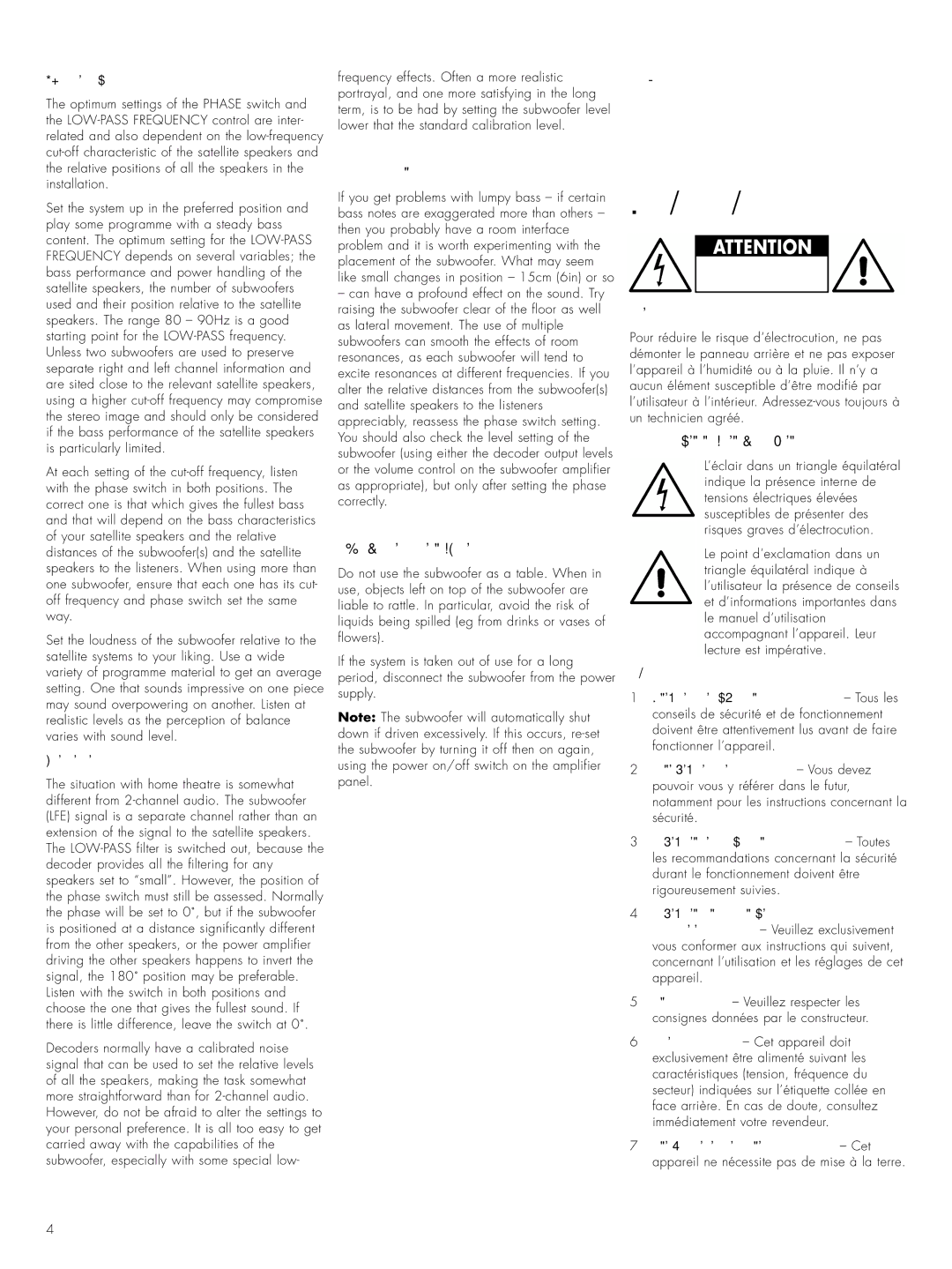
2-channel audio
The optimum settings of the PHASE switch and the
Set the system up in the preferred position and play some programme with a steady bass content. The optimum setting for the
At each setting of the
Set the loudness of the subwoofer relative to the satellite systems to your liking. Use a wide variety of programme material to get an average setting. One that sounds impressive on one piece may sound overpowering on another. Listen at realistic levels as the perception of balance varies with sound level.
Home theatre
The situation with home theatre is somewhat different from
Decoders normally have a calibrated noise signal that can be used to set the relative levels of all the speakers, making the task somewhat more straightforward than for
frequency effects. Often a more realistic portrayal, and one more satisfying in the long term, is to be had by setting the subwoofer level lower that the standard calibration level.
All applications
If you get problems with lumpy bass – if certain bass notes are exaggerated more than others – then you probably have a room interface problem and it is worth experimenting with the placement of the subwoofer. What may seem like small changes in position – 15cm (6in) or so
–can have a profound effect on the sound. Try raising the subwoofer clear of the floor as well as lateral movement. The use of multiple subwoofers can smooth the effects of room resonances, as each subwoofer will tend to excite resonances at different frequencies. If you alter the relative distances from the subwoofer(s) and satellite speakers to the listeners appreciably, reassess the phase switch setting. You should also check the level setting of the subwoofer (using either the decoder output levels or the volume control on the subwoofer amplifier as appropriate), but only after setting the phase correctly.
Taking care of the subwoofer
Do not use the subwoofer as a table. When in use, objects left on top of the subwoofer are liable to rattle. In particular, avoid the risk of liquids being spilled (eg from drinks or vases of flowers).
If the system is taken out of use for a long period, disconnect the subwoofer from the power supply.
Note: The subwoofer will automatically shut down if driven excessively. If this occurs,
FRANÇAIS
IMPORTANTES INSTRUCTIONS CONCERNANT LA SÉCURITÉ
ATTENTION
RISQUE D’ÉLECTROCUTION
NE PAS OUVRIR
Attention :
Pour réduire le risque d’électrocution, ne pas démonter le panneau arrière et ne pas exposer l’appareil à l’humidité ou à la pluie. Il n’y a aucun élément susceptible d’être modifié par l’utilisateur à l’intérieur.
Explication des symboles graphiques :
L’éclair dans un triangle équilatéral indique la présence interne de tensions électriques élevées susceptibles de présenter des risques graves d’électrocution.
Le point d’exclamation dans un triangle équilatéral indique à l’utilisateur la présence de conseils et d’informations importantes dans le manuel d’utilisation accompagnant l’appareil. Leur lecture est impérative.
PRÉCAUTIONS IMPORTANTES :
1Lisez ce manuel d’utilisation – Tous les conseils de sécurité et de fonctionnement doivent être attentivement lus avant de faire fonctionner l’appareil.
2Conservez ce manuel – Vous devez pouvoir vous y référer dans le futur, notamment pour les instructions concernant la sécurité.
3Suivez les recommandations – Toutes les recommandations concernant la sécurité durant le fonctionnement doivent être rigoureusement suivies.
4Suivez les instructions de fonctionnement – Veuillez exclusivement vous conformer aux instructions qui suivent, concernant l’utilisation et les réglages de cet appareil.
5Installation – Veuillez respecter les consignes données par le constructeur.
6Alimentation – Cet appareil doit exclusivement être alimenté suivant les caractéristiques (tension, fréquence du secteur) indiquées sur l’étiquette collée en face arrière. En cas de doute, consultez immédiatement votre revendeur.
7Mise à la terre ou en phase – Cet appareil ne nécessite pas de mise à la terre.
4
